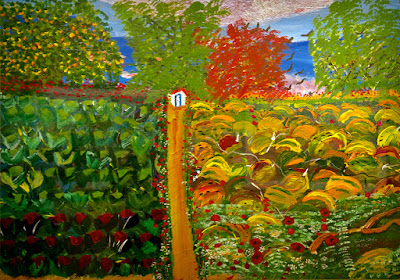John and I were impressed and moved by the drawings and paintings we saw at "Ceija Stojka: A Rom Artist of Her Century" at La Maison Rouge.
As a Rom child in Nazi-controlled Austria, Ceija Stojka (1933–2013), lived through some of the most horrifying events of the 20th century. Forty years afterward, without artistic training, she felt compelled to give form to her childhood memories in drawing and painting. She emerged a master artist in complete control of her media.
The portrait of the artist hangs beside this enormous, disembodied eye in the entrance to the show -- referring not only to Nazi surveillance but Ceija bearing witness to what she saw and experienced.
As a Rom child in Nazi-controlled Austria, Ceija Stojka (1933–2013), lived through some of the most horrifying events of the 20th century. Forty years afterward, without artistic training, she felt compelled to give form to her childhood memories in drawing and painting. She emerged a master artist in complete control of her media.
The portrait of the artist hangs beside this enormous, disembodied eye in the entrance to the show -- referring not only to Nazi surveillance but Ceija bearing witness to what she saw and experienced.
The paintings in the first room, all done in the 1990s, show aspects of Rom life before the Nazis came to power. The Simple Life of the Rom.
Untitled, acrylic on paper. A nomadic life in Austria.
The cozy interior of a caravan with 10 year-old Ceija and her mother.
A disquieting image -- the Nazis have taken power. The quiet life is over.
One of the central rooms of Ceija's exhibition dramatically presents her family hiding in a Vienna park after her father was arrested by the Gestapo.
In this detail of the above image, we see the frightened, wary eyes of her family peering out from park shrubs.
The large La Maison Rouge space has been showing cutting edge exhibitions since 2004.
"Where is your father? They took him." 1943. ink on paper, 2009
The terrifying arrests of Rom people is dramatically rendered from a child's point of view in this detail from Arrest and deportation, 1995.
The horror of life in the camps is bluntly obvious in Deportation to an extermination camp, 1994. Stojka survived three concentration camps -- Auschwits-Birkenau, Ravensbrück and Bergen-Belson.
Dachau, concentration camp, 1994. Acrylic on paper
A closer look at the top centre shows just how much drama is packed into this painting.
Life in the concentration camp buildings, Auschwitz, 31-44.
Cieja and her mother were moved from Auschwitz just before the Rom population imprisoned there were murdered. Final liquidation, Auschwitz, August 1944. 2002. acrylic on paper
Complacent expressions on the men in power.
Cieja poignantly captures her sense of spirits being released above the carnage of extermination in Z.B. (Zyklon B) Gas chamber, 1944, at Auschwitz -- The Liquidation .
Auschwitz, 1943/2011, drawing. To both the child and adult Ceija the crows flying over the camps represented the spirits of the dead.
Auschwitz, 1944, 2003
Birkenau KZ, 1944, 2009
Maman, Mamooo. We are free. We did not have a face yet. 2004. John told me that when he got to this powerful painting of freedom and release, Stojka began to sing a lullaby on the gallery soundtrack. Overwhelming.
The last section of Stojka's exhibition, Return to Life, is rich in colour and the abundance of nature. We will never forget the images in this show.
_______________________________________
Only four days left. Closes May 20th
_______________________________________
Only four days left. Closes May 20th























There are clearly so many (women) artists who have been overlooked over the years.
ReplyDeleteAnother amazing find. Sounds like a very interesting space.
I read that La maison rouge is closing this year. Any idea if they plan more exhibits after this group closes?
Keep up your terrific pace of exploration please!
LisaRR
Thanks for the compliments Lisa. This has been a great visit to Paris. Not sure if La Maison Rouge will continue in some form after May 20th. The space alone is amazing!
ReplyDeleteArt that makes you think.
ReplyDeleteArt that makes you feel.
Art that has the power to move you.
Is the best art of all.